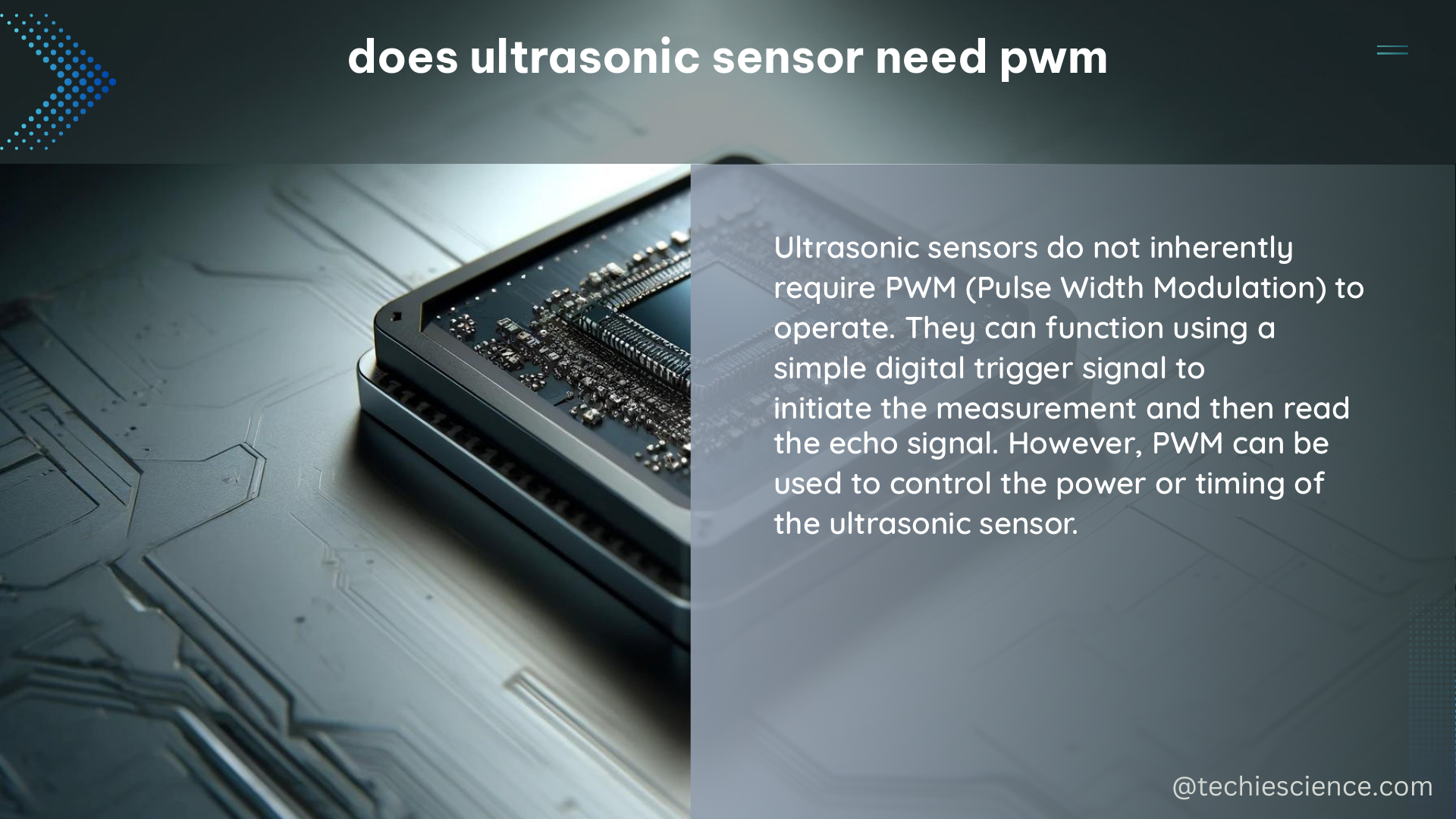Ultrasonic sensors are widely used in various applications, such as distance measurement, object detection, and proximity sensing. These sensors work by emitting high-frequency sound waves and measuring the time it takes for the waves to bounce back after hitting an object. While the Arduino’s PWM pins are often used to trigger ultrasonic sensors, they are not strictly required for the sensor to function properly.
Understanding the Ultrasonic Sensor Operation
Ultrasonic sensors, like the popular HC-SR04, operate by generating a 40kHz sound wave and measuring the time it takes for the wave to bounce back. This time measurement can then be used to calculate the distance to the object that the sound wave bounced off of.
The key components of an ultrasonic sensor are:
- Trigger Pin: This pin is used to initiate the sound wave emission. It requires a 10 microsecond pulse to trigger the sensor.
- Echo Pin: This pin outputs a TTL pulse, where the duration of the pulse is proportional to the time it took for the sound wave to bounce back.
To operate the sensor, the trigger pin is pulsed for 10 microseconds, which causes the sensor to emit a 40kHz sound wave. The sensor then listens for the echo, and the time between the trigger pulse and the echo pulse is used to calculate the distance.
Using PWM with Ultrasonic Sensors

While PWM pins are often used to trigger ultrasonic sensors, they are not strictly required. The reason PWM pins are commonly used is that they have a precise timing mechanism that can be used to generate the 10 microsecond trigger pulse.
However, it is also possible to use software PWM libraries or other digital pins to trigger the sensor. The key requirement is that the trigger pulse must be precisely 10 microseconds long, as this is the duration required to generate the 40kHz sound wave.
Here’s a comparison of using PWM pins and other digital pins to trigger an ultrasonic sensor:
| Feature | PWM Pins | Digital Pins |
|---|---|---|
| Timing Precision | High | Depends on software implementation |
| Ease of Use | Straightforward | Requires software PWM library |
| Potential for Interference | Lower | Higher, as multiple sensors may interfere with each other |
When using multiple ultrasonic sensors, it’s important to consider the potential for interference. If the sensors are triggered simultaneously, the sound waves from one sensor may interfere with the other, leading to inaccurate distance measurements. To avoid this, it’s recommended to trigger each sensor individually and allow enough time between triggers for the sound waves to dissipate.
Technical Specifications of the HC-SR04 Ultrasonic Sensor
The HC-SR04 is a popular ultrasonic sensor used in many DIY projects. Here are its key technical specifications:
- Operating Voltage: 5V
- Current Consumption: 15mA
- Measuring Angle: 15 degrees
- Measuring Range: 2cm to 400cm
- Resolution: 0.3cm
- Trigger Input Pulse Width: 10 microseconds
- Echo Output Signal: TTL pulse proportional to the distance of the target
These specifications are important to consider when designing projects that use the HC-SR04 ultrasonic sensor, as they will determine the sensor’s capabilities and limitations.
DIY Projects with Ultrasonic Sensors
Ultrasonic sensors are widely used in various DIY projects, such as:
- Distance Measurement: Measuring the distance to an object using the time-of-flight principle.
- Object Detection: Detecting the presence and location of objects in the sensor’s field of view.
- Robotic Navigation: Enabling robots to navigate their environment by detecting obstacles and measuring distances.
- Gesture Recognition: Detecting hand gestures or body movements to control various devices or interfaces.
- Level Sensing: Measuring the level of liquids or granular materials in containers.
These projects can be found in online communities like Arduino and Raspberry Pi forums, where enthusiasts share their experiences and provide detailed guides on how to implement these projects.
In conclusion, while PWM pins are often used to trigger ultrasonic sensors due to their precise timing mechanism, they are not strictly required. It is possible to use software PWM libraries or other digital pins to trigger the sensor, as long as the trigger pulse is precisely 10 microseconds long. When using multiple sensors, it’s important to consider the potential for interference and trigger each sensor individually to avoid inaccurate distance measurements.
References:
- How to use HC-SR04 ultrasonic sensor without hardware-pwm pins?
- How can I measure the PWM output of a ultrasonic sensor using NI?
- HC-SR04 User Guide
- The Application of PWM Capture (Data Acquisition) and Ultrasonic Sensors
- Do the echo and/or trig pins on an ultrasonic sensor require the use of a PWM pin?

The lambdageeks.com Core SME Team is a group of experienced subject matter experts from diverse scientific and technical fields including Physics, Chemistry, Technology,Electronics & Electrical Engineering, Automotive, Mechanical Engineering. Our team collaborates to create high-quality, well-researched articles on a wide range of science and technology topics for the lambdageeks.com website.
All Our Senior SME are having more than 7 Years of experience in the respective fields . They are either Working Industry Professionals or assocaited With different Universities. Refer Our Authors Page to get to know About our Core SMEs.